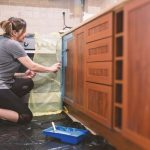By Kathleen Wilcox
Getting a home improvement project to pay off is notoriously tricky. There’s no guarantee you’ll recoup the money you pour into a bathroom remodel or an outdoor kitchen. Plus, the COVID-19 pandemic has made completing even minor projects more difficult, as many nonessential construction projects have been halted.
And while it might seem crazy to take on a big-ticket project in a time of economic uncertainty, many home buyers are still looking for turnkey properties with attractive amenities. So if you’re a seller with a house in need of a little TLC, you should focus on relatively low-budget upgrades that will seriously juice your home’s value.
Below, our experts spill on the improvements under $10,000 that buyers are perennially interested in, plus the trending ones whose popularity is likely to last.
Deep cleaning: $500 or less
Scuffs on doors, counters, cabinets, and walls; a ring of scum around a drain; cobwebs in basement corners; toys or tools peppering lawns and patios—these all look bad in the eyes of potential buyers. Luckily, eradicating these blemishes doesn’t take much.
“Deep cleaning is one of the most important things you can do for a little money that dramatically increases your value in the market,” says Heather Wendlandt, a real estate agent with the San Diego-based Team Kolker. “The Magic Eraser and elbow grease can go a long way.”
She says deep cleaning, plus basic paint touch-ups, can increase home values by thousands.
Front-door upgrade: $2,000 or less
Thee front door is the first part of a home that a potential buyer will interact with, so it’s worth lavishing attention on every detail. A fresh coat of paint, new hardware, or updated accessories like house numbers, door knockers, and attractive lighting are all easy and relatively inexpensive to obtain.
Wilmington, NC–based real estate agent-turned-blogger Rebecca Fernandez says that when she was given a listing that sat on the market without activity for months, a front-door upgrade helped make a difference.
“I convinced the homeowners to provide me with a budget of $500,” Fernandez says. “It was a very small Cape Cod home, painted dark beige, with an unflattering wood front door. To add contrast, I purchased black vinyl shutters and painted the door a dark red. Next, we cleaned up the front lawn and purchased a door mat, flowerpots, and mums, since it was autumn, and we wanted it to have a fresh, seasonal look. After those minor tweaks, with new pictures online and the added curb appeal, we drew multiple buyers and sold the property quickly.”
Touchless fixtures and fresh-air systems: $200 to $5,000
During the pandemic, certain fixtures have become more relevant—and coveted—than ever.
What buyers want right now are touchless fixtures like sinks and toilets that eliminate your need to come into contact with a germ-filled surface, says Scott Campbell, team leader at Cedarburg, WI’s Re/Max. Both of these upgrades cost a few hundred dollars to install around the house.
Another pandemic must-have is excellent airflow.
“Updating mechanical systems and adding a RenewAire system that pulls fresh air into the home every few hours is a huge plus for buyers,” Campbell says. “Ultraviolet air exchanges that help kill viruses are also smart investments and very practical for home showings during the pandemic.”
Better kitchens and bathrooms: $9,000 or less
Kitchens and bathrooms that look outdated or cheap can sink the value of an entire home.
Tracy Jones, an associate with Re/Max Platinum Realty, witnessed firsthand how a kitchen face-lift boosted her home’s value.
“During the years we’ve done some hefty renos, but resurfacing our kitchen cabinets cost less than $4,000. We replaced the cheap-looking plywood cabinets with white doors and custom-built drawer fronts with soft-pull hardware,” she says. “We also upgraded the 1990s Formica countertops with granite for $4,000, creating a modern look.”
Jones believes these upgrades helped them bring in a profit. They bought the home for $189,000 in 2006 and sold it for $425,000 in 2020.
Bathrooms can also make or break a deal.
Erik Wright, owner of New Horizon Home Buyers in Chattanooga, TN, says he helped renovate and flip a home that cost him $80,000 and was sold for $140,000. Of the $15,000 he invested in home improvement, Wright put $9,000 toward upgrades on the kitchen and bathroom, including light fixtures, new cabinets and counters, fresh towels, and new vanities and faucets. All told, he cleared $45,000, primarily through minor tweaks.
Backyard upgrades: $500 to $10,000
Backyards are now thought of as an extension of the home.
“For those in the suburbs, pools, koi ponds, and fountains are newfound hot-selling items,” says Neal Clayton, licensed partner at Engel & Völkers in Nashville, TN. A small water feature that makes a soothing impression can be purchased and installed for as little as $500.
“Fire pits and outdoor kitchens with basic cabinetry are also frequently requested as people find creative ways to expand their living spaces,” Clayton says.
Home office: $10,000 or less
Home offices were on their way out before the pandemic, but they are all the rage now. Converting a room and buying all of the furniture, accoutrements, and shelving cost well under $10,000, experts say.
If you’re on the fence about carving out a home office space, consider this: Many buyers won’t consider a home these days if it doesn’t have a place where working or schooling from home is feasible.






